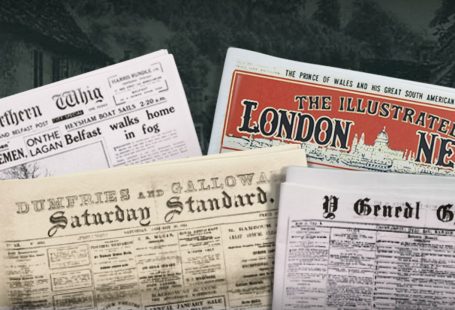This week for Easter, we took a look through our newspapers to find Easter traditions across the globe. The papers in the British Newspaper Archive report events from around the world as well as explore international customs and traditions. We found traditions in Romania, Russia, Bulgaria, France, and England.
Easter Customs
In 1933, The Sphere did a feature on Easter customs in many lands. In one image, you can see fishermen from Galilee, in present-day northern Israel. The caption tells us that the group worked all night, then on Easter day, they came ashore to make a fire and cook their catch. The tradition reflects the actions of Simon, Peter, and other disciples when Jesus Christ appeared to them on the shores of the lake.

In the same feature, The Sphere looked at the excitement of children from Spreewald, Germany at getting their Easter cakes. Throughout the year, children look forward to this Easter tradition.

The Sphere printed another photograph the following year of a child enjoying the Easter cake in Spreewald.

Both The Sphere and the Illustrated London News, printed illustrations of the tradition in Romania and Bulgaria of women visiting Christian prisoners and bringing them cakes. The cakes were decorated with a cross and were the early versions of our delicious hot cross buns.


First World War France
As the First World War was coming to an end and the Treaty of Versailles was being drawn up, the Riveria enjoyed their first peace-time Easter in years. The Graphic illustrated some local Easter traditions; such as congregations visiting the cake shop after services and a priest blessing a small wine shop on Easter.


Easter Eggs
Easter is never complete without Easter eggs. Traditionally, eggs were given as a present at Easter. Over Easter, eggs are dyed and decorated. But it is hard to match the extravagance of the Faberge egg. The Tatler in 1966, displayed four Imperial eggs created by Carl Faberge for the Russian Imperial family. The collection includes the Lilies of the Valley Egg, presented to dowager Empress Marie Feodorovna by Nicholas II from 1898.

In England, the tradition of rolling eggs became popular during the Victorian era. Participants generally used decorated boiled eggs. The decorated eggs, also known as pace eggs, are rolled down the English hillsides. The English have other traditions of sending objects rolling down hills like wheels of cheese and barrels (a topic for another blog). Particularly, the tradition has been kept by the county of Lancashire. In the Lancashire Evening Post < https://www.britishnewspaperarchive.co.uk/titles/lancashire-evening-post > from 8 April 1947, you can see a group of children admiring their eggs at Preston Park before they commence the egg rolling.

We also found a happy snapshot of children in Aberdeen rolling eggs in the Aberdeen Press and Journal.

In Illustrated Sporting and Dramatic News, we discovered an egg event involving skis. The event took place in the Swiss Alps at Villars-sur-Ollon. The athletes are required to ski from Chamossaire to Bretaye while stopping at five designated stations for pick up an egg. All five eggs need to make it safely to the bottom of the trail.

In this small example of newspapers, we have discovered that Easter is celebrated through a variety of activities throughout the world; from the origins of the hot cross buns in prisons to Lancashire egg rolling.
Subscribe today to discover more






